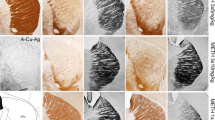Summary
Three days after the administration of MPTP (1-methyl-4-phenyl-1,2,3,6-tetrahydropyridine) or methamphetamine to mice, there is degeneration and disappearance of punctate tyrosine hydroxylase-containing synaptic endings in the caudate nucleus. The neuropil is occupied with longer, varicose, branching fibres, which appear to be preterminal fibres. An intense gliosis occurs. The sparsely-occurring glial cells, with profuse lightly-stained (by glial fibrillary acidic protein) processes which are primarily located near blood vessels, become transformed into more heavily-stained star-shaped cells with fewer but thicker processes. These cells are distributed throughout the caudate. Despite apparent differences in the mechanism by which MPTP and methamphetamine cause dopamine depletion, the neuropathological changes in the caudate induced by these substances are identical.
Similar content being viewed by others

References
Burns, R. S., Chiueh, C. C., Markey, S. P., Ebert, M. H., Jacobowitz, D. M. &Kopin, I. J. (1983) A primate model of parkinsonism: selective destruction of dopaminergic neurons in the pars compacta of the substantia nigra by N-methyl-4-phenyl-1,2,3,6-tetrahydropyridine.Proceedings of the National Academy of Sciences USA 80, 4546–50.
Heikkila, R. E., Hess, A. &Duvoisin, R. C. (1984) Dopaminergic neurotoxicity of l-methyl-4-phenyl- 1,2,5,6-tetrahydropyridine in mice.Science 224, 1451–3.
Heikkila, R. E., Hess, A. &Duvoisin, R. C. (1985) Dopaminergic neurotoxicity of l-methyl-4-phenyl- 1,2,5,6-tetrahydropyridine (MPTP) in the mouse: relationships between monoamine oxidase, MPTP metabolism and neurotoxicity.Life Sciences 36, 231–6.
Hess, A. (1989) Neuropathological changes in the caudate nucleus elicited by MPTP and their prevention by monoamine oxidase inhibition.Brain Research 499, 393–6.
Nwanze, E. &Jonsson, G. (1981) Amphetamine neurotoxicity on dopamine nerve terminals in the caudate nucleus of mice.Neuroscience Letters 26, 163–8.
Preston, K. L., Wagner, G. C., Schuster, C. R. &Seiden, L. S. (1985) Long-term effects of repeated methylam-phetamine administration on monoamine neurons in the rhesus monkey brain.Brain Research 338, 243–8.
Ricaurte, G. A., Guillery, R. W., Seiden, L. S., Schuster, C. R. &Moore, R. Y. (1982) Dopamine nerve terminal degeneration produced by high doses of methylamphetamine in the rat brain.Brain Research 235, 93–103.
Seiden, L. S., Fischman, M. W. &Schuster, C. R. (1975) Long-term methamphetamine-induced changes in brain catecholamine in tolerant rhesus monkeys.Drug and Alcohol Dependence 1, 215–19.
Sonsalla, P. K., Nicklas, W. J. &Heikkila, R. E. (1989) Role for excitatory amino acids in methamphetamine-induced nigrostriatal dopaminergic toxicity.Science 243, 398–400.
Author information
Authors and Affiliations
Rights and permissions
About this article
Cite this article
Hess, A., Desiderio, C. & McAuliffe, W.G. Acute neuropathological changes in the caudate nucleus caused by MPTP and methamphetamine: Immunohistochemical studies. J Neurocytol 19, 338–342 (1990). https://doi.org/10.1007/BF01188403
Received:
Revised:
Accepted:
Issue Date:
DOI: https://doi.org/10.1007/BF01188403



